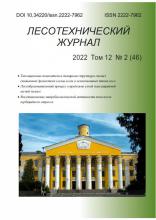Voronezh, Voronezh, Russian Federation
Suburban recreational forests of the city of Voronezh have medium-forming, water-protective, protective, aes-thetic, recreational value. As a result of increasing recreational loads, there are noticeable changes in natural complexes, their condition worsens and productivity decreases. The purpose of the study is to determine the vital state of trees in artificial pine plantations of various stages of digression by the phenotypic features of the trunk and crown and the development of methods for their diagnosis. In carrying out the studies, standard methods of forest inventory have been used with the corresponding cameral treatment. An algorithm is proposed to regulate the research. Detailed data are provided for each stage of work. With deterioration in the sanitary condition of the plantations, a significant decrease in the number of healthy trees has been revealed. The data of the revealed external signs of pathology in Scots pine in the studied stands are reflected. The most common anomaly in the 63-year-old stands of different stages of digression is the curvature of the trunks. Their number regularly increases from 15% in I stage to 63% in the V stage. Mechanical damage to the trunk (from 7% to 37%)are in the second place in the occurrence of I - IV stages of digression in plantations, stem rot (48%) - in the V stage. Such defects as taring and stem rot have the least spread in plantations of I-III stages of digression. The basis of natural regeneration in 63 years old forest cultures of Pinus sylvestris is pine single and group undergrowth of different ages. Indicators of the life condition of trees in conditions of recreational impact are: the shape of the trunk, the presence of multiversity, density and architectonics of the crown, the degree of drying, angle of the branch from the trunk in the lower, middle and upper parts of the crown. Scale for determining the viability of trees by phenotypic characteristics has been proposed. Measures were taken to restore disturbed stands using highly viable species and selected individuals.
Scots pine (Pinus sylvestris, L.), vital condition of trees, pathological signs, components of biogeocenosis, phenotypic signs, stage of digression
1. Kazanskaja N.S., Lanina V.V., Marfenin N.N. Rekreacionnye lesa [Recreational forests] Moscow, 1977, 96 p. (In Russian).
2. Prikaz Rosleshoza "Ob utverzhdenii metodicheskih dokumentov" Prilozhenie 2. Rukovodstvo po provede-niju sanitarno-ozdorovitel'nyh meroprijatij [The order of the Federal forestry Agency "On approval of methodological documents" Annex 2. Guidelines for conducting sanitary and health measures] ot 29 dekabrja 2007 g. N 523. Regime of access: www.SudAct.ru (In Russian).
3. Rysin L.P., Poljakova G.A. Vlijanie rekreacionnogo lesopol'zovanija na rastitel'nost': prirodnye aspekty rekreacionnogo ispol'zovanija lesa [The Influence of recreational forest management on vegetation: the natural aspects of recreational use of forests] Moscow, 1987, pp. 4-26. (In Russian).
4. Titov E.V. Lesovedenie: Jevoljucionnye i geneticheskie aspekty [Evolutionary and genetic aspects] Voronezh, 2002, 124 p. (In Russian). EDN: https://elibrary.ru/QQNJGS
5. Titov E.V. Podrost - cennyj genofond prirody dlja lesovosstanovlenija [Young valuable gene pool of nature for reforestation] Aktual'nye napravlenija nauchnyh issledovanij XXI veka: teorija i praktika: sbornik nauchnyh trudov po materialam mezhdunarodnoj zaochnoj nauchno-prakticheskoj konferencii [Actual directions of scientific researches of the XXI century: theory and practice: collection of scientific papers on materials of international correspondence scientific-practical conference] Voronezh, 2017, pp. 179-183. (In Russian). EDN: https://elibrary.ru/YQESEN
6. Tkachenko M.E. Obshhee lesovodstvo [General forestry] Moscow, Leningrad, 1955, 600 p. (In Russian).
7. Tyrchenkova I.V. Vlijanie rekreacionnogo vozdejstvija na komponenty lesnogo fitocenoza chistyh 62 - letnih kul'tur sosny obyknovennoj [Influence of recreation impact on components of forest phytocenosis net 62 - year-old cultures of Scots pine] Lesotehnicheskij zhurnal [Journal of Forestry] 2017, pp. 96-104. (In Russian). EDN: https://elibrary.ru/YKVTPZ
8. Tyrchenkova I. V. Osobennosti lesovosstanovlenija v iskusstvennyh sosnovyh nasazhdenijah razlichnoj stadii digressii [Peculiarities of forest regeneration in artificial pine plantations of various stages of digression] Razvitie idej G. F. Morozova pri perehode k ustojchivomu lesoupravleniju: materialy mezhdunar. nauch.- prakt. jubilejnoj konf. 20-21 aprelja 2017 g. [The development of the ideas of G. F. Morozov in the transition to sustainable forest management: proceedings of the international. scientific.- pract. jubilee Conf. On April 20-21, 2017] Voronezh, 2017, pp. 235-238. (In Russian). EDN: https://elibrary.ru/NJTHLR
9. Bsaibes F. E. Biosocial mechanisms of forest ecosystems stability increase. Voronezh: Istoki, 2005, 92 p.
10. Debort S., Meyer D. Degradation de lecosysteme forestier: analyse et ebauchen de solutions. Schweiz. Z. Forstw. 1989, Vol. 11, pp. 965-976.
11. Münch E. Investigation of the hormony of tree shape. Jahrb. wiss. Bot. 1938. Bd. 86. No. 4, pp. 581-673.












